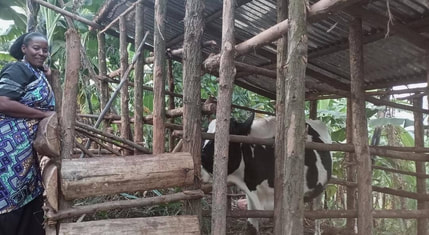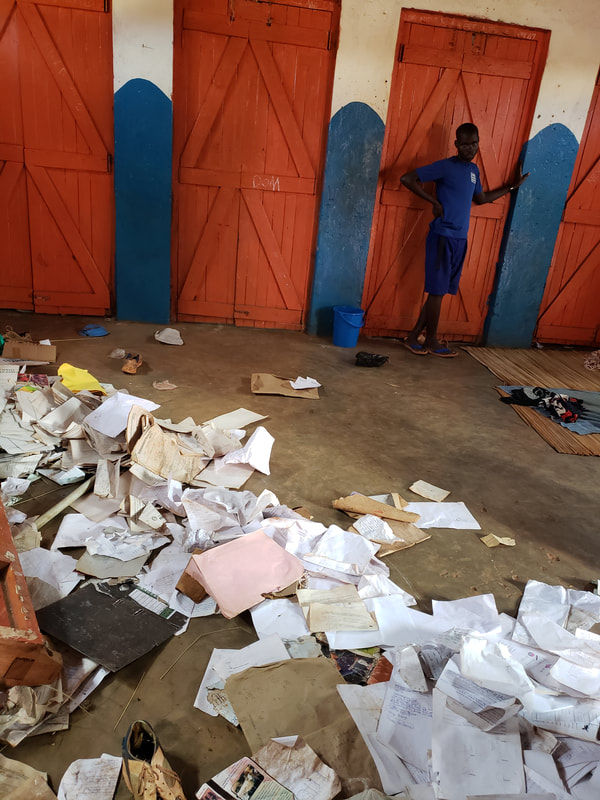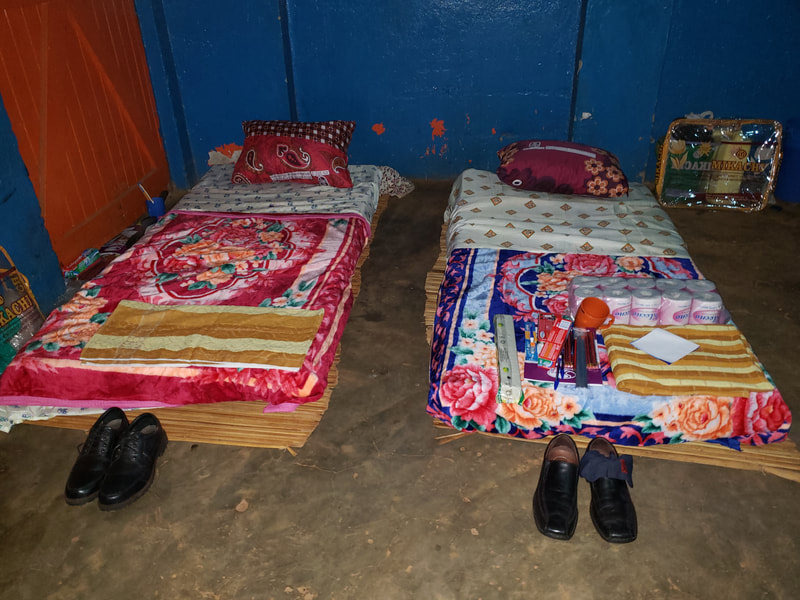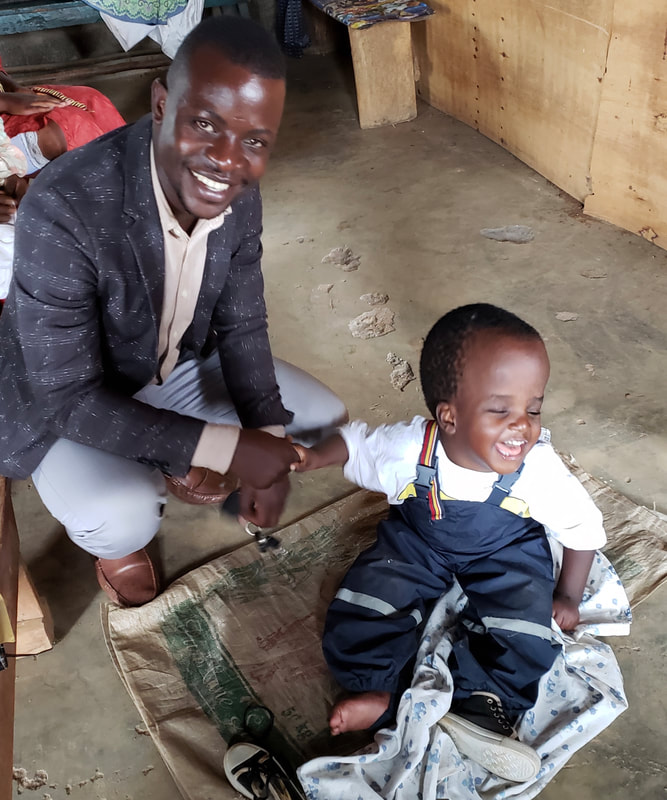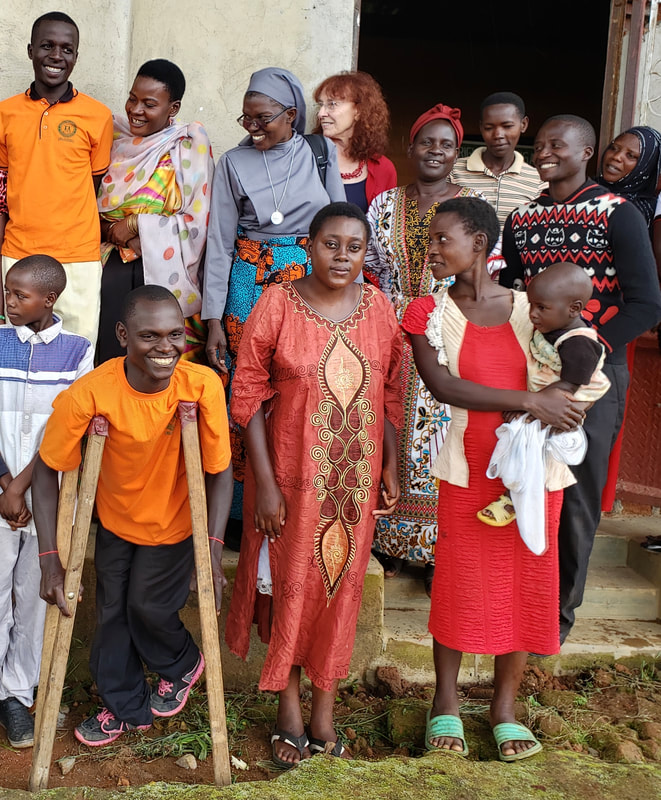October 22, 2022
It’s been over three months since my last Africa update (having then just returned from Uganda), but three years since I last spent October in Africa thanks to the huge disruption caused by the pandemic for the first two years, and now due to the timeline necessitated by the series of appointments for cataract surgeries – which were no big deal at all - new glasses, and upcoming treatment for somewhat routine complications from the lens implants, and even newer glasses. In 2020 I dropped the word “plan” from my vocabulary, but I hope to get back to Uganda this winter for an extended stay.
Meanwhile, with One Future at a Time, the beat goes on. Since early July with the in-person advocacy and facilitation by my angels on the ground in Uganda, Rwanda, South Africa, and Liberia, and you angels who continue to make this all possible, here’s what we’ve done so far:
Education: We have 12 active scholarships ranging from primary school through post-graduate degree programs. Some things are more than they seem on the surface, as is the case with one of our students named Margret, age 14. Many schools at all levels in Uganda have boarding sections, and I was surprised at first how commonly kids attend as boarders, even the youngest. The typical reasons are that the school is too far for the daily commute, or the parents or guardians work long hours or out of town and are not available to care for their children, or that because of poverty, the children are fed better at school than at home. None of this applied to Margret. She was a day student in the primary school we had associated with for several years, but at the beginning of last term, she begged the principal to stay as a boarder to avoid ongoing abuse at home. Her mother felt powerless to protect her and couldn’t afford the additional fees for room and board, so One Future at a Time agreed to give her a scholarship in order to provide her with a place of safety.
Urgent provisions: We are occasionally asked for help with once-off needs such as transportation for medical care or special dietary items prescribed for a health condition. This summer, we had a request that was a first, and what may seem minor and inexpensive here, was a big deal for a sweet 12-year-old girl named Mashudu in Olievenhoutbosch, my old “home” township in South Africa. In the past several years, in all the places I’ve been in Africa and I suspect other third world countries as well, there has been a push for keeping girls in school. One of the main reasons that girls miss a substantial amount of school is lack of supplies for menstrual hygiene, so a lot of charitable organizations have made it possible to distribute free sanitary pads (washable/reusable or disposable) at schools. I’ve known Mashudu since before she was born. She asked her mom to contact me via WhatsApp to tell me she was so excited about getting her first period and that they gave her pads at school. You might be wondering what’s the problem. Well, if your family is so poor that there’s no money to buy underwear, there’s nothing to stick the pads to. “Auntie, can you please help with some money to buy underwear?” A mere $15 was enough to buy two multi-packs of underwear. This is an example of why I cringe at anything advertised here as a “must have.” And if you think a small donation to One Future at a Time won’t do much, let that idea go out the window.
Healthcare: Just since July, we’ve provided 8 adults and 2 children in Uganda, South Africa, and Liberia with a range of services including medical care and surgery for illnesses and accidents; complex ophthalmology services; revision of a prosthetic leg, and follow-up physical therapy; dental care and oral surgery. One root canal here in Redding, CA can pay for 16 of them in Uganda – preferably not in the same mouth! And as long as I’m comparing costs, a trip to the hospital in an ambulance in Uganda’s capital city of Kampala averages the equivalent of about $450. My neighbor recently had a nine-mile ride to the hospital in an ambulance for $7,463. ________ [Fill in with the expression of your choice!]
It’s been over three months since my last Africa update (having then just returned from Uganda), but three years since I last spent October in Africa thanks to the huge disruption caused by the pandemic for the first two years, and now due to the timeline necessitated by the series of appointments for cataract surgeries – which were no big deal at all - new glasses, and upcoming treatment for somewhat routine complications from the lens implants, and even newer glasses. In 2020 I dropped the word “plan” from my vocabulary, but I hope to get back to Uganda this winter for an extended stay.
Meanwhile, with One Future at a Time, the beat goes on. Since early July with the in-person advocacy and facilitation by my angels on the ground in Uganda, Rwanda, South Africa, and Liberia, and you angels who continue to make this all possible, here’s what we’ve done so far:
Education: We have 12 active scholarships ranging from primary school through post-graduate degree programs. Some things are more than they seem on the surface, as is the case with one of our students named Margret, age 14. Many schools at all levels in Uganda have boarding sections, and I was surprised at first how commonly kids attend as boarders, even the youngest. The typical reasons are that the school is too far for the daily commute, or the parents or guardians work long hours or out of town and are not available to care for their children, or that because of poverty, the children are fed better at school than at home. None of this applied to Margret. She was a day student in the primary school we had associated with for several years, but at the beginning of last term, she begged the principal to stay as a boarder to avoid ongoing abuse at home. Her mother felt powerless to protect her and couldn’t afford the additional fees for room and board, so One Future at a Time agreed to give her a scholarship in order to provide her with a place of safety.
Urgent provisions: We are occasionally asked for help with once-off needs such as transportation for medical care or special dietary items prescribed for a health condition. This summer, we had a request that was a first, and what may seem minor and inexpensive here, was a big deal for a sweet 12-year-old girl named Mashudu in Olievenhoutbosch, my old “home” township in South Africa. In the past several years, in all the places I’ve been in Africa and I suspect other third world countries as well, there has been a push for keeping girls in school. One of the main reasons that girls miss a substantial amount of school is lack of supplies for menstrual hygiene, so a lot of charitable organizations have made it possible to distribute free sanitary pads (washable/reusable or disposable) at schools. I’ve known Mashudu since before she was born. She asked her mom to contact me via WhatsApp to tell me she was so excited about getting her first period and that they gave her pads at school. You might be wondering what’s the problem. Well, if your family is so poor that there’s no money to buy underwear, there’s nothing to stick the pads to. “Auntie, can you please help with some money to buy underwear?” A mere $15 was enough to buy two multi-packs of underwear. This is an example of why I cringe at anything advertised here as a “must have.” And if you think a small donation to One Future at a Time won’t do much, let that idea go out the window.
Healthcare: Just since July, we’ve provided 8 adults and 2 children in Uganda, South Africa, and Liberia with a range of services including medical care and surgery for illnesses and accidents; complex ophthalmology services; revision of a prosthetic leg, and follow-up physical therapy; dental care and oral surgery. One root canal here in Redding, CA can pay for 16 of them in Uganda – preferably not in the same mouth! And as long as I’m comparing costs, a trip to the hospital in an ambulance in Uganda’s capital city of Kampala averages the equivalent of about $450. My neighbor recently had a nine-mile ride to the hospital in an ambulance for $7,463. ________ [Fill in with the expression of your choice!]
July 8, 2022
I’ve been back from Uganda for a few weeks now, but have some more interesting things to share with you as well as good updates on the three One Future at a Time projects we were hoping to fund. Let’s start with that.
Last time I told you that we were able to provide funding for a Rwandese woman to purchase a dairy cow and calf and the materials and labor to build an enclosure for the animals. Yesterday I just received photos, so below you can see one very grateful mama who now has the means to provide milk for her son who needs a calcium-rich diet for his bone disorder (osteomyelitis) and the opportunity to generate enough income from selling milk such that she can afford the boy’s school fees.
Thanks to more OFaaT angels, Amos in Liberia had his surgery to repair that huge umbilical hernia and a hydrocele. The surgery was successful, but during his recovery, he contracted malaria, so his post-operative care has taken longer. We’re hoping by next week he and his mother will be able to return from the capital city (Monrovia) to their village. People from remote areas need to stay close to the hospital for a bit of extra time postoperatively because as you might imagine, if anything goes wrong afterwards and they are in some remote area, they would truly be out of luck.
I’ve been back from Uganda for a few weeks now, but have some more interesting things to share with you as well as good updates on the three One Future at a Time projects we were hoping to fund. Let’s start with that.
Last time I told you that we were able to provide funding for a Rwandese woman to purchase a dairy cow and calf and the materials and labor to build an enclosure for the animals. Yesterday I just received photos, so below you can see one very grateful mama who now has the means to provide milk for her son who needs a calcium-rich diet for his bone disorder (osteomyelitis) and the opportunity to generate enough income from selling milk such that she can afford the boy’s school fees.
Thanks to more OFaaT angels, Amos in Liberia had his surgery to repair that huge umbilical hernia and a hydrocele. The surgery was successful, but during his recovery, he contracted malaria, so his post-operative care has taken longer. We’re hoping by next week he and his mother will be able to return from the capital city (Monrovia) to their village. People from remote areas need to stay close to the hospital for a bit of extra time postoperatively because as you might imagine, if anything goes wrong afterwards and they are in some remote area, they would truly be out of luck.
December 16, 2019
As promised, here are more Uganda activities, this time in partnership with Education Forum Africa (EFA), our other partner organization, of which as of early this year I have been on the Board of Directors. We’re based in the capital city of Kampala but the work is mostly in some very remote rural areas. We focus on keeping kids in school and addressing the reasons they may not be attending. In many if not most cases, lack of money to pay for school fees, uniforms, and supplies is the main thing. Rural areas depend on income from various harvests (bananas, coffee, etc.), which is seasonal and meager at that. So many children are orphans or may as well be, given the frequency of abandonment. I am astounded by the numbers of children I’ve met who may or may not have a father in the picture AND have also been abandoned by their mothers, only to be raised by an impoverished grandmother who heads a household of children. In my email to you back in June, I explained the other issue relating more to girls not going to school, and we work on addressing those things as well: child marriage for girls, lack of menstrual hygiene supplies, and gender based violence (GBV) and abuse.
Uganda is a relatively small country, so there is a lot of collaboration between organizations. One Future at a Time, EFA, and A Bright Child-Uganda work as partners in sponsoring children’s education, and have paid school fees and bought uniforms and supplies to keep some of the most vulnerable children in school.
On an EFA outreach to a school in the town of Jinja in the northeast part of the country, we met two boys, ages 15 and 16 and unrelated, who were living at the school. One had been abandoned by both parents and the other had been abandoned by his mother and left with an abusive step-father, so he ran away. Neither had any way to pay school fees, but the school sort of adopted them and let them sleep there – not in the boarding section, which required fees, but on thin straw mats on the floor of a storage room, which was littered with paper trash. (See photo.) They had no pillows, no blankets, one large towel between them, no school uniforms, the clothes on their backs, and that’s about all. You, dear donors, bought them mattresses, pillows, bedding, bath towels, school uniforms and shoes, school supplies, and various necessities for daily living. And we paid their school fees. I wish I could convey to you their appreciation.
This is one of many similar stories, and let me happily add that four of these rural outreaches over the course of this fiscal year are being supported by a small grant we received from UNICEF-USA. There will always be more need than resources, so it’s important to celebrate our successes, and I want to share some of them with you since they wouldn’t be possible without you.
Charles, our little guy, now about 4 years old, with hydrocephalus whom I’ve updated you on periodically: 2 years ago, his head was so heavy with fluid that he couldn’t keep it upright, couldn’t sit without flopping over, and was blind from the pressure on his optic nerve. With the surgical, medical, and rehabilitative treatment we have paid for over the years, his vision has improved a bit, and when I saw him a few weeks ago, he was able to get himself from lying down to sitting up totally unassisted. This truly is a miracle. In the photo, he is with Isaac Lwanga, Director of ABC-Uganda. Charles’s mother expressed her great appreciation, but one thing really stood out. She said that because of her son’s unusual appearance, he was stigmatized and no one would touch him. It meant so much to her that I touched him as someone would touch any child. On my part, I didn’t give holding a child’s hand a second thought, but it just goes to show that the simplest of kindnesses can be so significant to another person.
Mary, age 16: I first met and described her to you in April. She had some severe neurological deficit after an undiagnosed incident 5 years ago that left her mute and not able to voluntarily interact with her environment. We took her for a thorough physical assessment and she was treated for toxoplasmosis, a parasitic brain infection. After all this time, complications had set in and her family had given up hope, but with ongoing rehabilitation, she has slowly progressed, and the milestones are that she can now write her name and can do simple tasks at home and in the family garden – and here’s hoping for more milestones. In the group photo, Mary is in the front row, center, with her mother and baby sister on the right. The fact that she was engaged enough to look straight ahead at the photographer rather than hanging her head down as usual is also a sign of progress. We take nothing for granted.
By the way, the woman standing behind them with the red headscarf is Charles’s mother. And next to Mary on the other side is Vincent, who I wrote about in my last email a couple of weeks ago. With gratitude, let me say that two of you are his angels. One of you as I previously mentioned, donated for us to get him his hot-rod wheelchair, and now another of you has made a generous donation with a specific designation to purchase an industrial knitting machine for him to use at our vocational school so that he can work on contract with a local business to make scarfs and school sweaters. We were practically in tears as he expressed his thanks for this opportunity that had previously been unimaginable. You can’t tell very well from the photo, but those crutches are way too short for him, so I think we’ll spring for better crutches.
Staying with the same photo, the young man on the far right with the black sweater is a 21-year-old named Francis. He looks hale and hearty, but what you don’t see is that he lost his right leg as a passenger on a motorcycle taxi (boda boda) accident and cannot afford a prosthesis. I intend for One Future at a Time to get that for him, and with it would come some physical therapy for rehabilitation.
Christine: She is our teenage girl who is legally blind. I wrote about her last year. She is a very intelligent young lady and somehow managed by having school friends tell her what was written on the blackboard, which she couldn’t see, and in her books, which she could read only with great strain, holding the written materials literally in front of her nose. We took her to a specialty eye clinic where she got the strongest prescription glasses I’ve ever heard of, plus additional magnifiers for reading. She came to visit me a few weeks ago, all dressed up and smiling, and we sat outside visiting by some bushes with beautiful tropical flowers cascading down. Here’s an example of her success… In the middle of our conversation, she saw an ant on my forearm and picked it off. I hope you understand what a big deal this was for someone so visually impaired.
These small miracles happen because of your support as well as your encouragement and friendship, and from the heart, I wish you many blessings in return.
Donations can be made by:
☐ Depositing a check to One Future at a Time in any branch of Bank of America, writing on the back “For deposit only to One Future at a Time” and the account number (3250 1095 5956).
☐ Mailing a check made out to One Future at a Time to 3640 Riverview Drive, Redding, CA 96001-3932.
☐ Donating by credit card right from our website www.onefutureatatime.com or from the “Learn More” button on our Facebook page, which links you directly to our website donation page.
As promised, here are more Uganda activities, this time in partnership with Education Forum Africa (EFA), our other partner organization, of which as of early this year I have been on the Board of Directors. We’re based in the capital city of Kampala but the work is mostly in some very remote rural areas. We focus on keeping kids in school and addressing the reasons they may not be attending. In many if not most cases, lack of money to pay for school fees, uniforms, and supplies is the main thing. Rural areas depend on income from various harvests (bananas, coffee, etc.), which is seasonal and meager at that. So many children are orphans or may as well be, given the frequency of abandonment. I am astounded by the numbers of children I’ve met who may or may not have a father in the picture AND have also been abandoned by their mothers, only to be raised by an impoverished grandmother who heads a household of children. In my email to you back in June, I explained the other issue relating more to girls not going to school, and we work on addressing those things as well: child marriage for girls, lack of menstrual hygiene supplies, and gender based violence (GBV) and abuse.
Uganda is a relatively small country, so there is a lot of collaboration between organizations. One Future at a Time, EFA, and A Bright Child-Uganda work as partners in sponsoring children’s education, and have paid school fees and bought uniforms and supplies to keep some of the most vulnerable children in school.
On an EFA outreach to a school in the town of Jinja in the northeast part of the country, we met two boys, ages 15 and 16 and unrelated, who were living at the school. One had been abandoned by both parents and the other had been abandoned by his mother and left with an abusive step-father, so he ran away. Neither had any way to pay school fees, but the school sort of adopted them and let them sleep there – not in the boarding section, which required fees, but on thin straw mats on the floor of a storage room, which was littered with paper trash. (See photo.) They had no pillows, no blankets, one large towel between them, no school uniforms, the clothes on their backs, and that’s about all. You, dear donors, bought them mattresses, pillows, bedding, bath towels, school uniforms and shoes, school supplies, and various necessities for daily living. And we paid their school fees. I wish I could convey to you their appreciation.
This is one of many similar stories, and let me happily add that four of these rural outreaches over the course of this fiscal year are being supported by a small grant we received from UNICEF-USA. There will always be more need than resources, so it’s important to celebrate our successes, and I want to share some of them with you since they wouldn’t be possible without you.
Charles, our little guy, now about 4 years old, with hydrocephalus whom I’ve updated you on periodically: 2 years ago, his head was so heavy with fluid that he couldn’t keep it upright, couldn’t sit without flopping over, and was blind from the pressure on his optic nerve. With the surgical, medical, and rehabilitative treatment we have paid for over the years, his vision has improved a bit, and when I saw him a few weeks ago, he was able to get himself from lying down to sitting up totally unassisted. This truly is a miracle. In the photo, he is with Isaac Lwanga, Director of ABC-Uganda. Charles’s mother expressed her great appreciation, but one thing really stood out. She said that because of her son’s unusual appearance, he was stigmatized and no one would touch him. It meant so much to her that I touched him as someone would touch any child. On my part, I didn’t give holding a child’s hand a second thought, but it just goes to show that the simplest of kindnesses can be so significant to another person.
Mary, age 16: I first met and described her to you in April. She had some severe neurological deficit after an undiagnosed incident 5 years ago that left her mute and not able to voluntarily interact with her environment. We took her for a thorough physical assessment and she was treated for toxoplasmosis, a parasitic brain infection. After all this time, complications had set in and her family had given up hope, but with ongoing rehabilitation, she has slowly progressed, and the milestones are that she can now write her name and can do simple tasks at home and in the family garden – and here’s hoping for more milestones. In the group photo, Mary is in the front row, center, with her mother and baby sister on the right. The fact that she was engaged enough to look straight ahead at the photographer rather than hanging her head down as usual is also a sign of progress. We take nothing for granted.
By the way, the woman standing behind them with the red headscarf is Charles’s mother. And next to Mary on the other side is Vincent, who I wrote about in my last email a couple of weeks ago. With gratitude, let me say that two of you are his angels. One of you as I previously mentioned, donated for us to get him his hot-rod wheelchair, and now another of you has made a generous donation with a specific designation to purchase an industrial knitting machine for him to use at our vocational school so that he can work on contract with a local business to make scarfs and school sweaters. We were practically in tears as he expressed his thanks for this opportunity that had previously been unimaginable. You can’t tell very well from the photo, but those crutches are way too short for him, so I think we’ll spring for better crutches.
Staying with the same photo, the young man on the far right with the black sweater is a 21-year-old named Francis. He looks hale and hearty, but what you don’t see is that he lost his right leg as a passenger on a motorcycle taxi (boda boda) accident and cannot afford a prosthesis. I intend for One Future at a Time to get that for him, and with it would come some physical therapy for rehabilitation.
Christine: She is our teenage girl who is legally blind. I wrote about her last year. She is a very intelligent young lady and somehow managed by having school friends tell her what was written on the blackboard, which she couldn’t see, and in her books, which she could read only with great strain, holding the written materials literally in front of her nose. We took her to a specialty eye clinic where she got the strongest prescription glasses I’ve ever heard of, plus additional magnifiers for reading. She came to visit me a few weeks ago, all dressed up and smiling, and we sat outside visiting by some bushes with beautiful tropical flowers cascading down. Here’s an example of her success… In the middle of our conversation, she saw an ant on my forearm and picked it off. I hope you understand what a big deal this was for someone so visually impaired.
These small miracles happen because of your support as well as your encouragement and friendship, and from the heart, I wish you many blessings in return.
Donations can be made by:
☐ Depositing a check to One Future at a Time in any branch of Bank of America, writing on the back “For deposit only to One Future at a Time” and the account number (3250 1095 5956).
☐ Mailing a check made out to One Future at a Time to 3640 Riverview Drive, Redding, CA 96001-3932.
☐ Donating by credit card right from our website www.onefutureatatime.com or from the “Learn More” button on our Facebook page, which links you directly to our website donation page.
